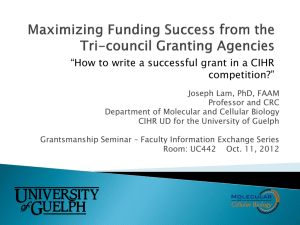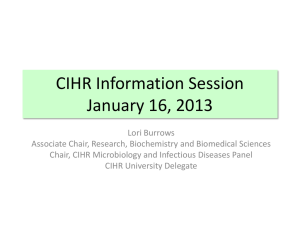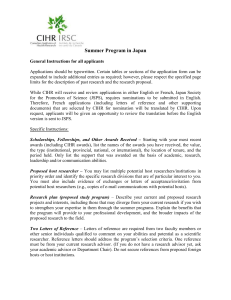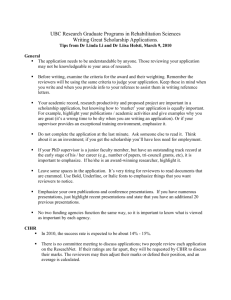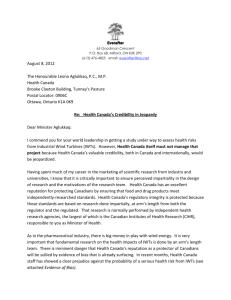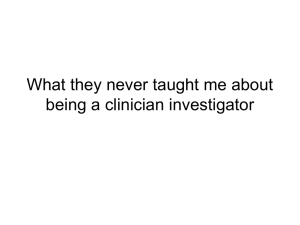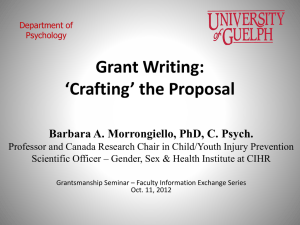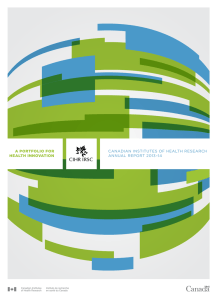Response of the Canadian Society of Biochemistry, Molecular and
advertisement
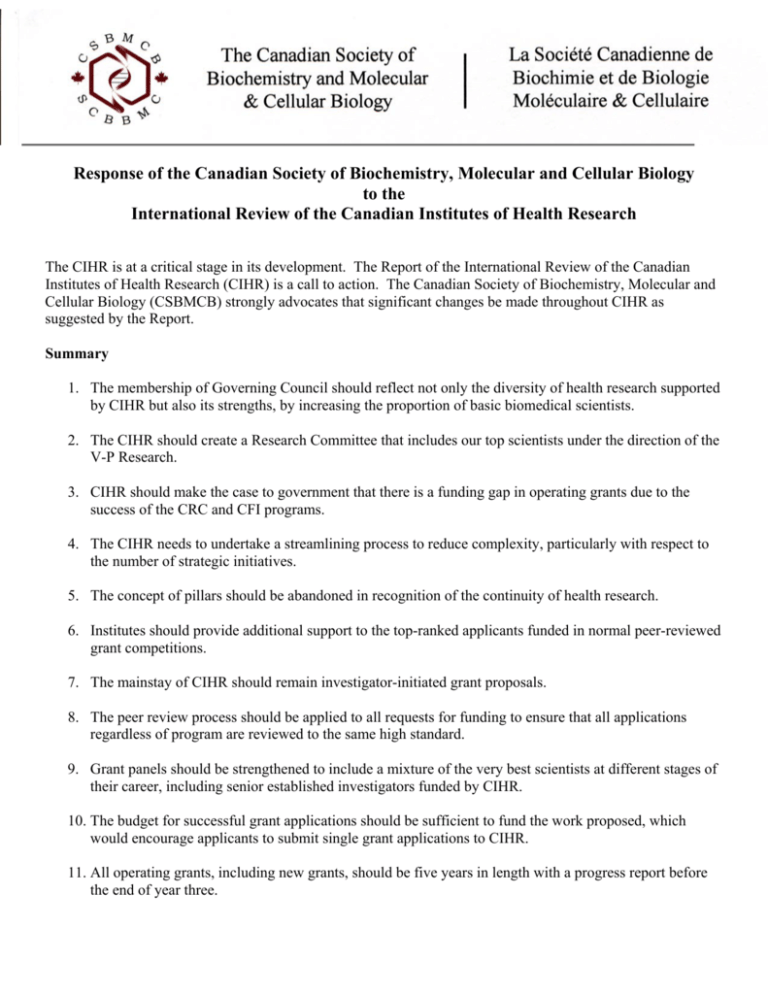
Response of the Canadian Society of Biochemistry, Molecular and Cellular Biology to the International Review of the Canadian Institutes of Health Research The CIHR is at a critical stage in its development. The Report of the International Review of the Canadian Institutes of Health Research (CIHR) is a call to action. The Canadian Society of Biochemistry, Molecular and Cellular Biology (CSBMCB) strongly advocates that significant changes be made throughout CIHR as suggested by the Report. Summary 1. The membership of Governing Council should reflect not only the diversity of health research supported by CIHR but also its strengths, by increasing the proportion of basic biomedical scientists. 2. The CIHR should create a Research Committee that includes our top scientists under the direction of the V-P Research. 3. CIHR should make the case to government that there is a funding gap in operating grants due to the success of the CRC and CFI programs. 4. The CIHR needs to undertake a streamlining process to reduce complexity, particularly with respect to the number of strategic initiatives. 5. The concept of pillars should be abandoned in recognition of the continuity of health research. 6. Institutes should provide additional support to the top-ranked applicants funded in normal peer-reviewed grant competitions. 7. The mainstay of CIHR should remain investigator-initiated grant proposals. 8. The peer review process should be applied to all requests for funding to ensure that all applications regardless of program are reviewed to the same high standard. 9. Grant panels should be strengthened to include a mixture of the very best scientists at different stages of their career, including senior established investigators funded by CIHR. 10. The budget for successful grant applications should be sufficient to fund the work proposed, which would encourage applicants to submit single grant applications to CIHR. 11. All operating grants, including new grants, should be five years in length with a progress report before the end of year three. 12. Grant panels should place sufficient emphasis on the recent track record of the investigator as a measure of future productivity. The CSBMCB advocates the following steps be taken: 1. The membership of Governing Council should reflect not only the diversity of health research supported by CIHR but also its strengths, by increasing the proportion of basic biomedical scientists. The Report recommends that the Governing Council operate as the main board of the organization. As such, it should reflect the diversity of health research that it supports. The Society feels that basic biomedical science does not have adequate representation on Governing Council given the number of researchers working in this area. The recent appointment of Brett Finlay (UBC) is a positive development in this direction. 2. The CIHR should create a Research Committee that includes our top scientists under the direction of the V-P Research. We agree with the report that “a single research committee should be established to monitor all research expenditure and to agree on the balance of strategic and response mode of funding in each area of research.” This Committee should include our best scientists. 3. CIHR should make the case to government that there is a funding gap in operating grants due to the success of the CRC and CFI programs. The report recognizes that other national (CRC, NCE, CFI, Genome Canada, etc.) and provincial initiatives (FRSQ, AHFMR, etc.) have significantly increased the demand for operating support from CIHR. It is essential that the lines of communication between these agencies be enhanced such that duplication is avoided and cooperation is strengthened. The linkage between CRC and CFI is an example of the coordination that can occur. 4. The CIHR needs to undertake a streamlining process to reduce complexity, particularly with respect to the number of strategic initiatives. The report recognizes the complexity of CIHR, with 13 Institutes, often with overlapping interests, an increase in the number of grant panels, a bewildering number of strategic initiatives and a growing bureaucracy. The Society strongly believes that the majority of funding should be for investigatorinitiated peer-reviewed grants, adjudicated through the usual grant panel mechanism. This would result in significant streamlining and ensure a fair and equitable review process. Strategic initiatives should be for areas that need development or for new initiatives such as the Training Programs. Grant panels should not be created to deal with “boutique” areas of research. 5. The concept of pillars should be abandoned in recognition of the continuity of health research. Research is a continuum. There has been too much discussion about the four pillars of research and the balance of activities within and between them. The discussion has not been helpful and is in fact divisive. 6. Institutes should provide additional support to the top-ranked applicants funded in normal peerreviewed grant competitions. The CSBMCB feels that all proposals should be reviewed to the same high standard. Institutes could identify within the pool of top-ranked grants, those that are within its priority areas. The top-ranked applicant could be identified as an “Investigator of the Institute of…” and be given supplemental funding and a small career award. This way, Institutes are aligned with the best applicants and not only with those below the cut-off. Many Institutes have a natural connection with certain panels and these linkages could be strengthened. 7. The mainstay of CIHR should remain investigator-initiated grant proposals. The Report deals extensively with the balance of strategic and investigator-lead research. A minimum of 75% of the total research budget should be allocated for investigator-initiated research. Established areas of research should have a higher percentage, while strategic initiatives, team grants, etc. should be applied only to priority areas needing development. 8. The peer review process should be applied to all requests for funding to ensure that all applications regardless of program are reviewed to the same high standard. The Report applauds the peer-review system, but recognizes that it is under strain. The Society feels strongly that the CIHR should apply the same standards of excellence throughout its funding programs. 9. Grant panels should be strengthened to include a mixture of the very best scientists at different stages of their career, including senior established investigators funded by CIHR. Grant panels are under increasing strain due to the increased number of applications. While it is important the grants panels contain a diversity of investigators, it is important that senior established investigators serve on the panels. 10. The budget for successful grant applications should be sufficient to fund the work proposed, which would encourage applicants to submit single grant application to CIHR. Too often the budget allocated to a successful grant is not sufficient to support the work proposed. This often leads investigators to write multiple grants to CIHR for quite related projects. This is inefficient, since investigators spend time composing extra grants that then must be review by an already strained peer-review system. We recognize the average size of grants has increase over the 6-year life of CIHR. We would like to see this trend continue such that grants meet the true cost of research, including adequate stipends for graduate students and post-doctoral fellows. 11. All operating grants, including new grants, should be five years in length with a progress report before the end of year three. We recognize that it is difficult for the CIHR engage in long-term planning since they are unable to carry forward funding from year to year and that the government has not provided a multi-year budget plan. However increasing the length of grants will have some major positive effects including: more inventive and risky research can be undertaken, there will be a decrease in the number of grant applications, and new investigators will have sufficient time to develop their research programs and be properly evaluated. 12. Grant panels should place sufficient emphasis on the recent track record of the investigator as a measure of future productivity. The best indicator of future success is past success. While it is essential that all grant applications be written in a clear and compelling manner, the publication record of the application in the previous funding cycle should be emphasized during the grant review process. Often the proposal is reviewed by nonexperts in the field who find faults that may not be significant, or with which the investigator is fully capable of dealing. Submitted by the CSBMCB Executive, August, 2006
